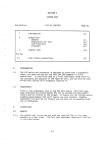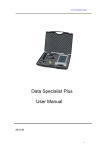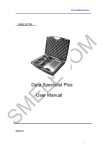Download M68HC705E6PGMR PROGRAMMER USER`S MANUAL F re e s c a
Transcript
Freescale Semiconductor, Inc... M68HC705E6PGMR/D2 Freescale Semiconductor, Inc. Oct 1993 M68HC705E6PGMR PROGRAMMER USER'S MANUAL Motorola reserves the right to make changes without further notice to any products herein to improve reliability, function or design. Motorola does not assume any liability arising out of the application or use of any product or circuit described herein; neither does it convey any license under its patent rights nor the rights of others. Motorola products are not designed, intended, or authorized for use as components in systems intended for surgical implant into the body, or other applications intended to support or sustain life, or for any other application in which the failure of the Motorola product could create a situation where personal injury or death may occur. Should Buyer purchase or use Motorola products for any such unintended or unauthorized application, Buyer shall indemnify and hold Motorola and its officers, employees, subsidiaries, affiliates, and distributors harmless against all claims, costs, damages, and expenses, and reasonable attorney fees arising out of, directly or indirectly, any claim of personal injury or death associated with such unintended or unauthorized use, even if such claim alleges that Motorola was negligent regarding the design or manufacture of the part. Second Edition © MOTOROLA Ltd., 1993 For More Information On This Product, Go to: www.freescale.com Freescale Semiconductor, Inc... Freescale Semiconductor, Inc. 1. INTRODUCTION This user's manual describes the programming technique used to program and verify the MC68HC705E6 (or MC68HC705P3) microcontroller (MCU) internal OTPROM/EPROM. All that is required to program the MC68HC705E6 (or MC68HC705P3) OTPROM/EPROM MCU is the PGMR and a +5 volt and VPP dc power supply. The PGMR can be fabricated for either 28 pin dual in-line (DIP) MCU device programming, 44 pin quad flat pack (QFP) MCU programming or small outline 28 pin (SOIC) MCU device programming. 2. PROGRAMMING TECHNIQUE 2.1 PARALLEL MODE The parallel PGMR programming technique allows the user program, contained in an external EPROM, to be copied into the internal PROM (OTPROM/EPROM) of the MC68HC705E6 (or MC68HC705P3) MCU device. This mode is selected by placing a link across pins 1 and 2 of jumper JP1. The MC68HC705E6 (or MC68HC705P3) MCU device is inserted the appropriate socket on the PGMR . The applicable program/verify routine is selected via switches S3 and S4, and power is applied to the PGMR via switch S1. The MCU is taken out of reset and placed in the run mode via switch S2, and MCU control is transferred to the bootstrap ROM. The selected programming routine is then executed. PROGRAMMERS USER MANUAL For More Information On This Product, 1-2 Go to: www.freescale.com MOTOROLA HC705E6PGMR/D2 Freescale Semiconductor, Inc... 2.1.1 PROGRAMMING THE MCU PROM (PARALLEL) Freescale Semiconductor, Inc. To select the program mode switch S3 and S4 should both be set to the ON position. In the program MCU PROM routine, the contents of an external 32K EPROM are copied into the MCU PROM areas of the applicable device. There is a direct correlation of addresses between the two devices. Non-MCU PROM addresses are ignored so data contained in those areas are not accessed. Unprogrammed external EPROM address locations should contain $00 to speed up the programming operation. During the programming routine, the PROGRAM LED D2 is illuminated. At the end of the programming routine, D2 is turned off, and the verification routine is entered. If the contents of the MCU PROM and external EPROM exactly match, then the VERIFY LED D3 is illuminated. During the verification routine, all locations are compared to the data residing in external EPROM. The verification routine will stop if a discrepancy has been detected and the error address location will be placed on the external memory address bus. 2.1.2 VERIFY MCU PROM (PARALLEL) To select the verify mode switch S3 should be set to the ON position and switch S4 should be set to the OFF position. The verify MCU PROM contents routine is normally entered automatically after the MCU PROM is programmed. Direct entry of this mode will cause the MCU PROM contents to be compared to external EPROM contents residing at the same address locations. Both D2 and D3 LEDs are turned off at this time until verification is completed. Upon completion of the verification routine (every location verified) the VERIFIED LED D3 is illuminated. If D3 does not illuminate, a discrepancy has been detected and the error address location will be placed on the external memory address bus. NOTE MCU PROM blank checking can be accomplished by placing $00 into the external EPROM (SKT1) and following the above verify MCU PROM routine. 2.2 SERIAL MODE This mode is selected by placing a link across pins 2 and 3 of jumper JP1. The serial mode allows communication with the device in a number of ways. One way is via a load RAM and execute routine. In this mode of operation code can be downloaded into the internal RAM of the MCU and a jump to the start of the downloaded code made. In the other mode of operation a special talker program is executed. This talker allows the user to communicate with a computer in a simple manner. For further information please contact Motorola. For More Information On This Product, PROGRAMMERS USER MANUAL Go to: www.freescale.com HC705E6PGMR/D2 MOTOROLA 1-3 Freescale Semiconductor, Inc... PROGRAMMING MODULE PREPARATION Freescale Semiconductor, Inc. The PGMR must be prepared/configured prior to any program/verify operations. Board preparation consists of the external power source (+5V and V PP), EPROM installation, DIP, SOIC, or QFP PGMR configuration. External Power Source Power connector P1 is used to connect an external power supply to the PGMR. A +5 Vdc @ 100 mA power source is connected to connector P1 pins labeled +5V and GND. The programming voltage power source is connected to pins labeled V PP and GND. Refer to the specific device data sheet for programming voltage (VPP) specifications. NOTE The programming voltage (V PP) must be measured at SKT2 pin 1 during programming cycle (D3) PROGRAM LED illuminated. EPROM Installation The basic EPROM device used on the PGMR (at location SKT1) is a 27256 or 27C256, 32K EPROM, 28-pin device. This EPROM device contains the user code to be programmed into the applicable PROM MCU device. DIP PGMR Configuration For the dual-in-line package (DIP) device programming, the PGMR printed wiring board (PWB) must be fabricated with a DIP zero-insertion-force (ZIF) socket located at SKT2. SOIC PGMR Configuration For the small chip carrier (SOIC) device programming, the PGMR printed wiring board (PWB) must be fabricated with a SOIC zero-insertion-force (ZIF) socket located at SKT3. QFP PGMR Configuration For quad flat pack (QFP) MCU device programming, the PGMR PWB must be fabricated with QFP ZIF sockets located at SKT 4. PROGRAMMERS USER MANUAL For More Information On This Product, 1-4 Go to: www.freescale.com MOTOROLA HC705E6PGMR/D2 Freescale Semiconductor, Inc... PROGRAMMING OPERATION Freescale Semiconductor, Inc. To program the MC68HC705E6 (or MC68HC705P3) MCU PROM, perform the following steps: 1. Place switch S1 to POWER-OFF (left) position. 2. Install MCU and EPROM devices into PGMR. 3. Place switch S2 to RESET-IN (left) position. 4. Check that the following are set : JP1 - Parallel position S3 - ON position S4 - ON position NOTE : S3 and S4 are three position switches. Do not set these switches to the middle position. 5. Place switch S1 to POWER-ON (right) position. 6. Place switch S2 to RESET-OUT (right) position. PROGRAM LED illuminates signifying programming sequence being performed. VERIFY LED illuminates signifying verification is completed. 7. Place switch S2 to RESET-IN (left) position. 8. Remove power (via S1), or select and run new routine. VERIFY OPERATION To verify the MC68HC705E6 MCU PROM, perform the following steps: 1. Place switch S1 to POWER-OFF (left) position. 2. Install MCU and EPROM devices into PGMR. 3. Place switch S2 to RESET-IN (left) position. 4. Check that the following are set : JP1 - Parallel position S3 - ON position S4 - OFF position NOTE : S3 and S4 are three position switches. Do not set these switches to the middle position. 5. Place switch S1 to POWER-ON (right) position. 6. Place switch S2 to RESET-OUT (right) position. VERIFY LED illuminates signifying verification is completed. 7. Place switch S2 to RESET-IN (left) position. 8. Remove power (via S1), or select and run new routine. For More Information On This Product, PROGRAMMERS USER MANUAL Go to: www.freescale.com HC705E6PGMR/D2 MOTOROLA 1-5 Freescale Semiconductor, Inc... Freescale Semiconductor, Inc. Motorola reserves the right to make changes without further notice to any products herein to improve reliability, function or design. Motorola does not assume any liability arising out of the application or use of any product or circuit described herein; neither does it convey any license under its patent rights nor the rights of others. Motorola products are not designed, intended, or authorized for use as components in systems intended for surgical implant into the body, or other applications intended to support or sustain life, or for any other application in which the failure of the Motorola product could create a situation where personal injury or death may occur. Should Buyer purchase or use Motorola products for any such unintended or unauthorized application, Buyer shall indemnify and hold Motorola and its officers, employees, subsidiaries, affiliates, and distributors harmless against all claims, costs, damages, and expenses, and reasonable attorney fees arising out of, directly or indirectly, any claim of personal injury or death associated with such unintended or unauthorized use, even if such claim alleges that Motorola was negligent regarding the design or manufacture of the part. PROGRAMMERS USER MANUAL For More Information On This Product, 1-6 Go to: www.freescale.com MOTOROLA HC705E6PGMR/D2















